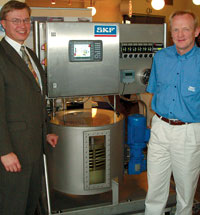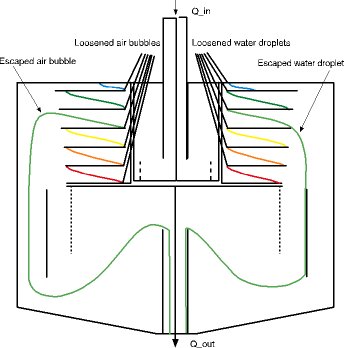
Motion Control dropped in on the 9th International Tribology Conference at the University of Pretoria in April to meet with Ray Mullen, GM – Lubrication Solutions at SKF South Africa, Vincent Correia, product specialist – Lubrication Systems at SKF South Africa and their Finnish visitors Matti Löppönen, GM of SKF Lubrication Solutions and professor Jari Rinkinen from the Department of Intelligent Hydraulics and Automation at Tampere University of Technology.

Correia was at the conference to present a paper titled 'Practical field results of a new reservoir design in a circulating oil lubrication system' while Rinkinen was presenting `New reservoir design revolutionises traditional circulating oil lubrication concepts'.
The challenge
In the mid 1990s, Löppönen was working for Finnish company Safematic. One of Safematic's major markets in Finland was the pulp and paper industry, where lubrication systems suffer from high levels of water and air contamination. Both of these contaminants affect the ability of lubrication systems to function effectively since oxidation reduces the life of a lubricant and their presence can lead to emulsification and foaming.
Löppönen challenged Rinkinen to rethink the century-old design of oil circulation systems and come up with a completely new design which would more effectively separate entrained air and water from the lubricant and reduce foaming.
Computer modeling
Rinkinen spent some two and a half years studying existing designs and developing computer-based mathematical models of existing and possible new designs. The models started right from first principles, where Stokes' Law can be used to model the movement of air bubbles and water droplets in oil.
At an approximation Stokes' Law reveals that a 1 mm water droplet in lubricating oil will take 30 minutes to fall 1 m and a 0,5 mm air bubble will take 30 minutes to rise 1 m in lubricating oil at normal operating temperature experienced in a lubrication oil reservoir. Larger droplets and bubbles will travel faster.
Based on these principles the design direction was determined by considering how to effectively reduce the distance which a droplet or bubble needed to travel.
The solution was to include a series of horizontal baffle plates with relatively close spacing such that droplets would only have a short distance to fall and bubbles a short distance to rise (see Figure 1). The shape of these separator plates was further optimised to look something like a wave washer in which air bubbles would travel radially toward the high point of the wave and water droplets would travel radially toward the low point of the wave. Each high point then vents to a central breather pipe which leads to the conical apex of the reservoir while each low point drains to a drain pipe leading to the conical bottom of the reservoir.

As water droplets gather on the upper side of a separator plate and fall down the surface they tend to combine into larger drops which then travel faster. Similarly, small air bubbles on the lower surface of a separator plate combine to form larger bubbles which travel faster.
The study led to a rethink of the reservoir shape itself. In the conventional shoe-box design oil flows horizontally at near constant velocity and interrupted by a few vertically mounted baffles. In the developed design the body of the reservoir is a vertical cylinder in which oil flows radially from the centre. This means that the cross-sectional area of the flow path increases as the oil moves outwards from the centre. The consequent drop in velocity helps the separation effect.
The conventional design also suffers from hydraulic tunnelling in which the main flow of oil follows a clear stream and the rest of the oil in the reservoir is in dead volumes which do not move. The model of the proposed cylindrical design indicated that there would be almost no dead volume.
One of the mathematical challenges faced by Rinkinen was that of coming up with a single measurement factor (performance index) with which the modelled performance of existing and proposed designs could be described.
The computer models for the prototype design suggested that it would be able to effectively separate droplets and air bubbles three times smaller than conventional designs with a reservoir one third of the size of a conventional system. Contributors to this improved performance were the shorter distance that small droplets and bubbles were required to travel, the accumulation effect of droplets, the accumulation effect of bubbles, the lower velocity of oil flow and the elimination of almost all dead oil volume.
Flowline filter
The modelling and theoretical design phase of this project took more than two years and it was only on completion of these stages that a prototype unit was built. Then the development team performed extensive tests on the prototype to validate that the actual performance was in accordance with the computer model.
The outcome was the Flowline filter, to which SKF now holds the patent after acquiring Safematic in 2004.
The Flowline uses a variable speed drive for the oil pump. This yields energy savings and also helps to prolong oil life because of lower hydraulic shear forces vs. fixed speed drives which use an overcapacity pump and pressure relief valve combination in which oil is being subjected to unnecessary shear all the time.
A 1000 litre Flowline system can achieve the same level of separation as a 3000 litre conventional system and experience has shown that it does not require any external dehydrator. This ratio is in line with the computer models which calculated a performance index of 94 for the Flowline vs. 34 for a conventional reservoir design.
The lower capacity reservoir means that the filter takes up less real estate in a plant, costs less to fill and represents a reduced fire hazard.
Löpppönen says that in most applications where this technology has been introduced over the last 10 years the oil has never been replaced and the system becomes almost 'Fill for life'. Of course, there is always some new oil being added to make up for losses.
There are currently two South African pulp and paper installations using this technology and a third one is expected to be commissioned during 2008.
For more information contact SKF South Africa, +27 (0)11 821 3500, [email protected], www.skf.co.za
| Tel: | +27 11 821 3500 |
| Fax: | +27 11 821 3501 |
| Email: | [email protected] |
| www: | www.skf.co.za |
| Articles: | More information and articles about SKF South Africa |

© Technews Publishing (Pty) Ltd | All Rights Reserved